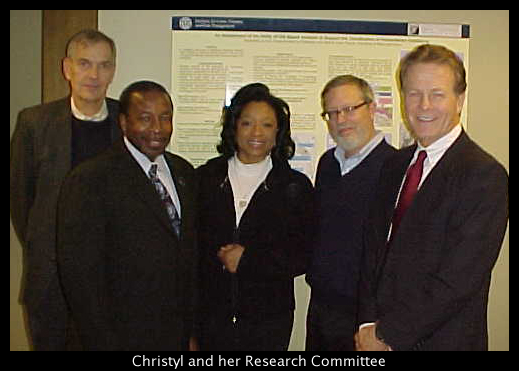On December 8, 2010, doctoral candidate Christyl C. Johnson successfully defended her research proposal on her topic “Environmental Life Cycle Criteria for Making Decisions about Green Versus Toxic Propellant Selections.” As related in another article in this newsletter, Christyl recently was named Deputy Director for Science and Technology at NASA's Goddard Space Flight Center. Christyl previously served as the Executive Director of the National Science and Technology Council, Office of Science and Technology Policy at the White House, and before that was a NASA Assistant Associate Administrator in the agency’s headquarters in Washington, D.C.
Christyl’s Research Committee consists of Dr. Michael Duffey (academic advisor), Dr. Gregory Shaw, Dr. Woodrow Whitlow (NASA Associate administrator for Mission Support and former Director of NASA’s John H. Glenn Research Center, and former Deputy Director of the John F. Kennedy Space Center in Florida) and E&EM; Lead Professor Dr. Jonathan Deason.
Christyl’s research is focused on questions regarding environmental life cycle costs of development, operation, and disposal of emerging “green” propellants as compared to the environmental life cycle costs associated with toxic fuels. Specifically, Christyl intends to examine the degree to which worker safety and toxic fuel containment and release mitigation are the biggest environmental cost drivers for manufacturing, storing, operating, and disposing of high energy fuels.
Current US and foreign launch systems in the public domain use ammonium perchlorate as the propellant of choice for their solid propulsion systems. Unfortunately, this fuel comes with a significant trade-off in risk as it relates to hazards to humans and the environment in the handling, transport, storage, and disposal. Since ammonium perchlorate contains chlorine, it produces large amounts of hydrochloric acid during the combustion process. Hydrochloric acid, when released into the atmosphere, has been known to have negative effects on the environment and, when combined with the effects of a hypergolic propellant like hydrazine, can present a serious danger to humans in the event of a catastrophic failure.
In addition, ammonium perchlorate cannot enable the kind of extended lunar missions and manned Mars missions that are anticipated to be prominent features of the nation’s vision for space exploration. Since a rocket system cannot be designed large enough to store enough fuel to launch, perform exploration and rendezvous missions, and return safely to Earth, the propellant must be one that can be replenished while on the surface of the Moon or Mars. The alternative propellant that will be used as test bed to examine Christyl’s hypotheses is proposed to be ammonium dinitramide. Its chemical composition is has as base elements only hydrogen, nitrogen, and oxygen (no chlorine).
In her research, Christyl proposes to define a set of decision criteria to be used to perform trade analysis for fuel selection decisions. Such criteria might include environmental, economic, performance, and risk characteristics, and did not account for many of the costs incurred. She intends to provide the decision makers with decision tools that will reflect a more accurate consideration of the actual multidimensional costs that must be considered. With such tools, one potentially can bridge the gap between traditional investment and return on investment models in a timeframe that can be acceptable to the investment decision makers.


